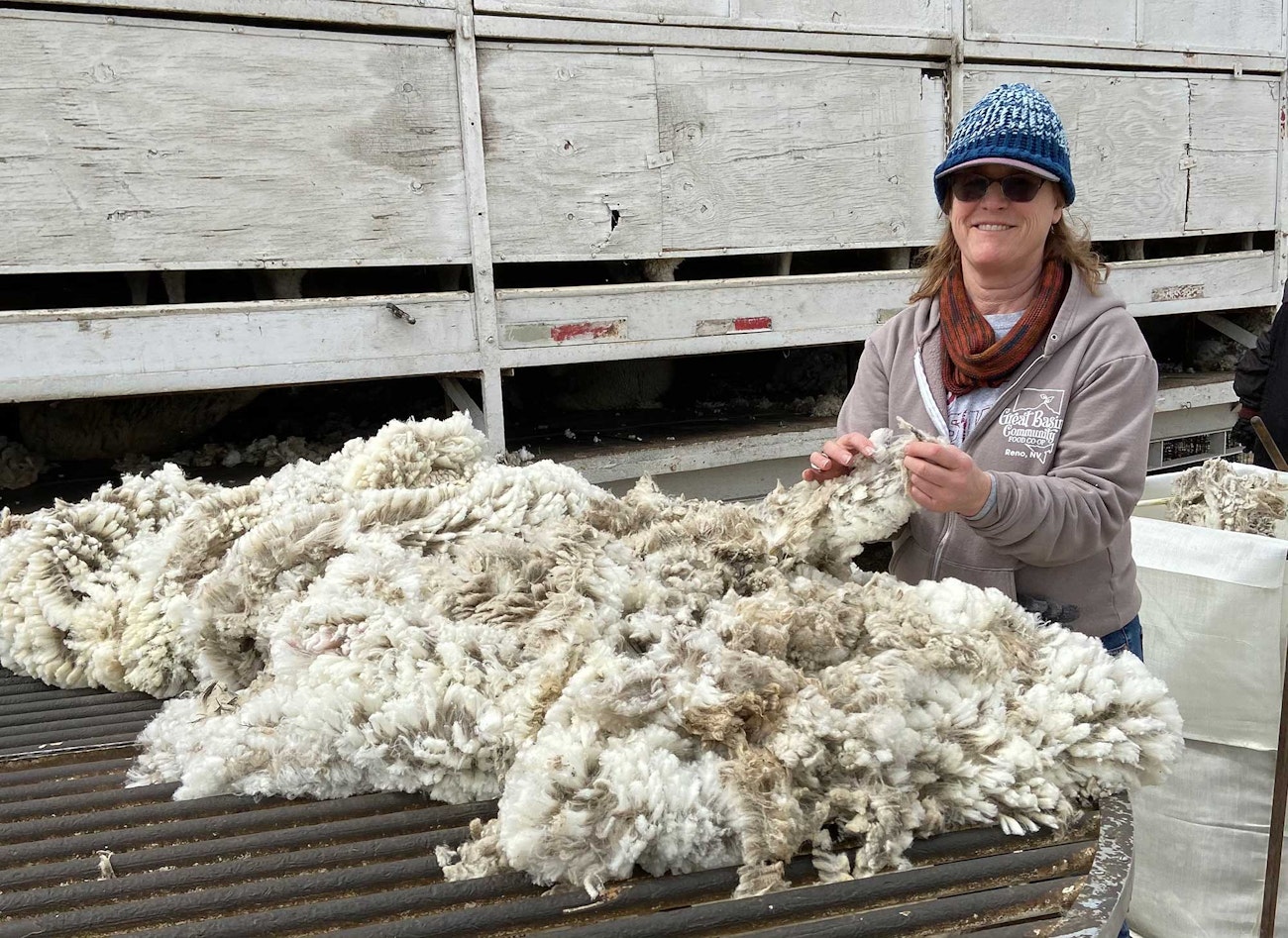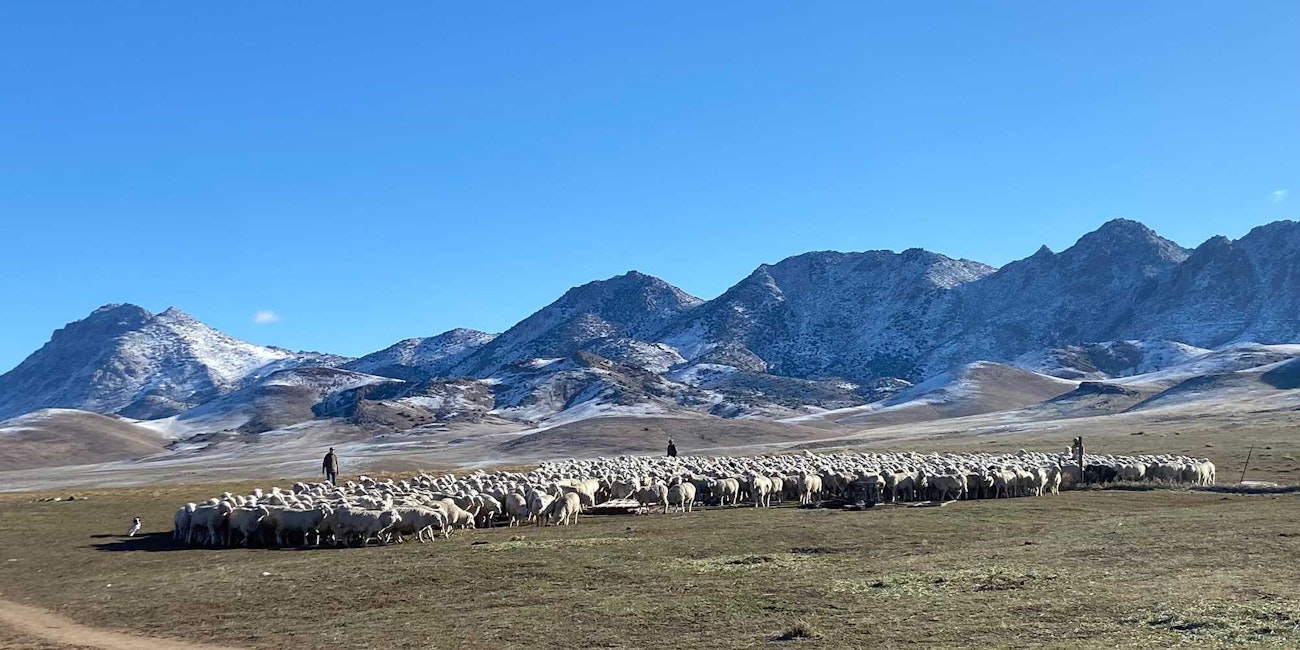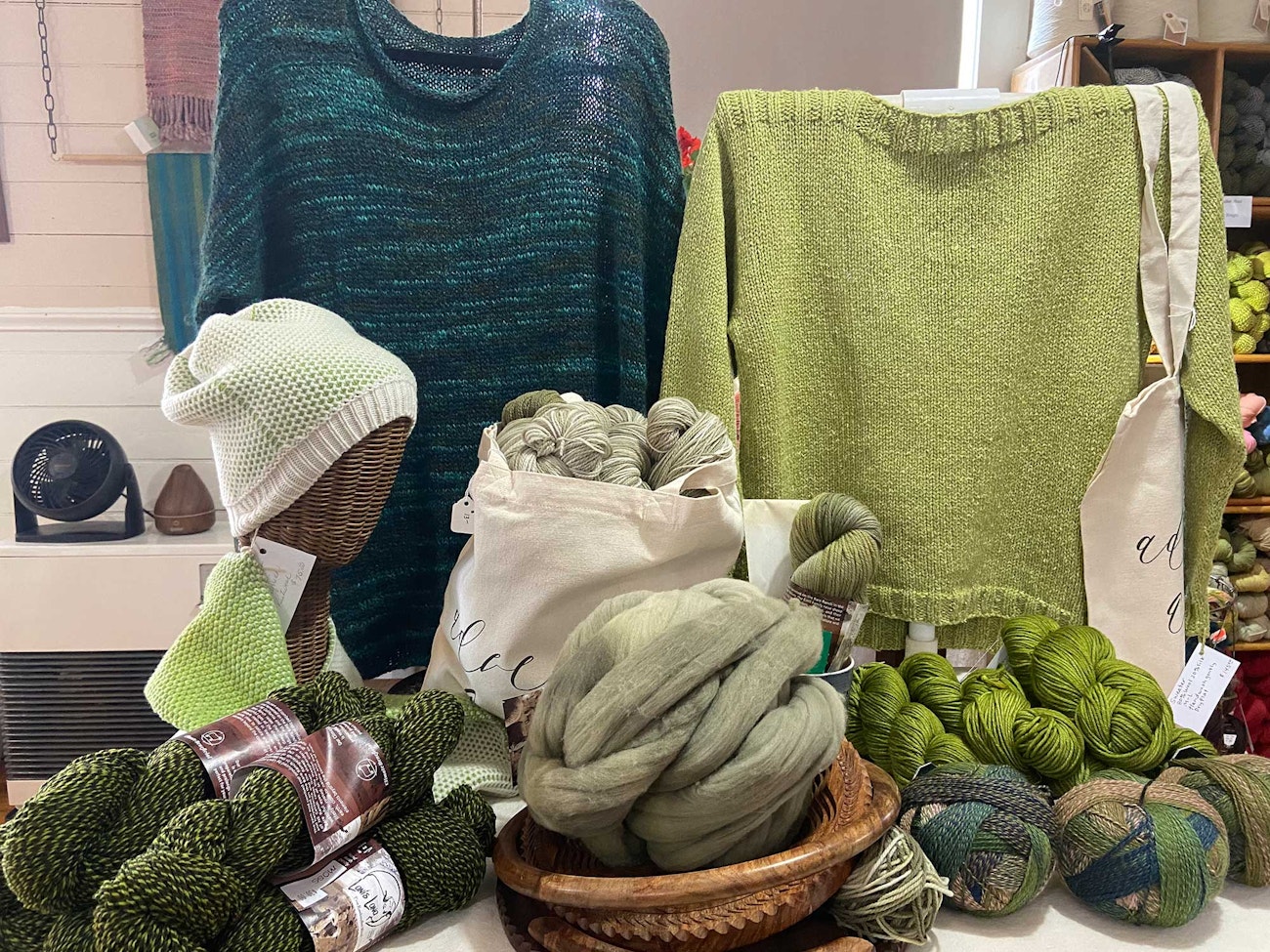https://farmfiberknits.com/cdn-cgi/image/format=auto/https://www.datocms-assets.com/101500/1741295470-lani-rambouillet-flock.jpg?auto=format&w=900
In the high-desert, sagebrush steppe of far northeastern California, where a pollinator strip on the Bare Ranch coincides roughly with the Nevada state line, Lani Cockrell creates and stewards family, flock, and community. Her home base is the town of Cedarville, the rough midpoint in the Surprise Valley between the Warner Mountains and Hays Canyon Range. Anyone who calls this the “middle of nowhere” or says “there’s nothing here” simply hasn’t learned to see it yet.
Since her start in the early 2000s, Lani wanted to offer handspinners and fiber artists a superfine, homegrown wool from northern California/northwest Nevada with all-American processing. The farthest her fiber travels is the eastern United States. Since then, Lani’s Lana Fine Rambouillet Wool has evolved from a flock of finewool sheep to roving, yarn, fabric, and bulk sales to garment designers and fashion brands, as well as natural-dye foraging and gardening, robust class offerings and retreats, and a 60-page Carbon Farm Plan (CFP) developed with the help of climate scientists and conservation specialists.
A Commitment to Regenerative Grazing
Today, Lani’s sheep graze 90,000 acres, always on the move, never overgrazing, tended by shepherds. The acreage is a combination of private and leased land including public lands managed by Bureau of Land Management (BLM) and US Forest Service (USFS), the Modoc National Forest among them.
This attention to and prioritization of local and regenerative practices has earned Lani’s products both Fibershed and Climate Beneficial fiber certifications. A fibershed is defined as a roughly 150-mile surrounding region from which all fibers, dyes, and labor are sourced. The Climate Beneficial Verification program recognizes that natural fibers “can be grown and raised in ways that maximize the drawdown of carbon from the atmosphere to help restore ecosystem health and stabilize our climate.” Fibershed (a nonprofit organization) verifies and monitors those practices on the land.
Lani herself is energetic, creative, and resourceful, an exemplar of appreciating what you’ve got, using what thrives nearby, and leaving things better than you found them. She is a critical holder and sharer of cultural and agricultural memory, preserving while passing things on.
SUBSCRIBER EXCLUSIVE
In the high-desert, sagebrush steppe of far northeastern California, where a pollinator strip on the Bare Ranch coincides roughly with the Nevada state line, Lani Cockrell creates and stewards family, flock, and community. Her home base is the town of Cedarville, the rough midpoint in the Surprise Valley between the Warner Mountains and Hays Canyon Range. Anyone who calls this the “middle of nowhere” or says “there’s nothing here” simply hasn’t learned to see it yet.
Since her start in the early 2000s, Lani wanted to offer handspinners and fiber artists a superfine, homegrown wool from northern California/northwest Nevada with all-American processing. The farthest her fiber travels is the eastern United States. Since then, Lani’s Lana Fine Rambouillet Wool has evolved from a flock of finewool sheep to roving, yarn, fabric, and bulk sales to garment designers and fashion brands, as well as natural-dye foraging and gardening, robust class offerings and retreats, and a 60-page Carbon Farm Plan (CFP) developed with the help of climate scientists and conservation specialists.
A Commitment to Regenerative Grazing
Today, Lani’s sheep graze 90,000 acres, always on the move, never overgrazing, tended by shepherds. The acreage is a combination of private and leased land including public lands managed by Bureau of Land Management (BLM) and US Forest Service (USFS), the Modoc National Forest among them.
This attention to and prioritization of local and regenerative practices has earned Lani’s products both Fibershed and Climate Beneficial fiber certifications. A fibershed is defined as a roughly 150-mile surrounding region from which all fibers, dyes, and labor are sourced. The Climate Beneficial Verification program recognizes that natural fibers “can be grown and raised in ways that maximize the drawdown of carbon from the atmosphere to help restore ecosystem health and stabilize our climate.” Fibershed (a nonprofit organization) verifies and monitors those practices on the land.
Lani herself is energetic, creative, and resourceful, an exemplar of appreciating what you’ve got, using what thrives nearby, and leaving things better than you found them. She is a critical holder and sharer of cultural and agricultural memory, preserving while passing things on.[PAYWALL]
 Lani Cockrell, a certified wool classer, skirts her Rambouillet fleeces during spring shearing at the Bare Ranch.
Lani Cockrell, a certified wool classer, skirts her Rambouillet fleeces during spring shearing at the Bare Ranch.
Rambouillet, Rafter Seven, and Range
Lani’s business name—Lani’s Lana Fine Rambouillet Wool—recognizes the sheep that started it all. Rambouillet are a finewool breed that thrives on the open range. They are large with a strong flocking instinct, long-lived, tough, and hardy. They can withstand heat, cold, and drought, producing lambs and uniform fleeces (with a nice amount of lanolin) under harsh conditions.
In the American West, grazing animals (both wild and domesticated) generally move to higher ground in summer, when the grasses and hills at lower elevations dry out and turn brown. Up in the mountains, the days are cooler, and there is abundant grass, snowmelt, and water. The sheep return to the lower-elevation, high desert basin for the winter season. And it’s the same cycle every year—seasonal memory tied to the even longer memory of landscape.
Lani remembers taking her children (especially Anna and Cole, her two middle ones) to Rafter Seven ram sales about 20 years ago. The Rafter Seven name is synonymous with top finewool sheep genetics of Merino and Merino/Rambouillet and is owned and managed by the University of Nevada, Reno. “I would go to buy Rambouillet bucks, and other people were paying big bucks for fancy Merinos,” Lani says.
 Lani's Rambouillet sheep.
Lani's Rambouillet sheep.
Fiber Preparation Matters
It’s not just the Rambouillet breed that makes Lani’s Lana roving so fine: the fiber preparation from raw fleece to combed top carries equal weight. Lani’s path to producing high-quality prepared fibers from her finewool fleeces took a lot of experimentation and frustrating trial and error to get right.
While Lani produces and sells combed preparations, her tops are often referred to as roving. “Roving” is often a catchall term for fiber prepared for spinning. It can refer to either top (as in combed top, a worsted prep) or sliver (pronounced sly-ver, a woolen prep). Top is the finest of the fine, the smoothest and most beautifully organized. “It has all the noil and short fibers removed and is combed so carefully,” Lani says. “Everything is straight.”
Lani recalls, “I had some fiber processed without combing and it was not as satisfying. Even though the fiber was fine, before it was combed, it had noils, and it felt like that bad, scratchy yarn everyone has bad childhood memories of. Once we saw it combed, we stopped all that—no more drumcarding, no picking. An enormous bag of nepps came with the first shipment of
combed fiber; it was amazing to see how much came out. When you use a combed-top preparation, it wears a lot nicer and you don’t have all that pilling.”
 Naturally dyed wool yarn and spinning fiber from Lani's Lana.
Naturally dyed wool yarn and spinning fiber from Lani's Lana.
Layered Natural Color, Foraged and Planted
In addition to roving for spinners, Lani’s Lana yarns are available either undyed, in their natural colors (including ravishing true black and charcoal), or naturally dyed. Lani uses botanical dyes, many foraged or home grown, on her yarns, a practice that began in partnership with the dearly departed Swan’s Island natural dye house in Maine. Swan’s Island used pigments including blues from indigo plants and pinks from cochineal beetle shells but now, she says, “I dye all of the ‘replacement yarns’ myself, in my studio in Cedarville, California.”
Lani’s hands and nature’s pigments create yarns that are not exactly variegated so much as layered, rich in dimension. The colorways are named for landscapes and plants near and dear to Lani’s heart: Lava is reminiscent of the rock at nearby Lassen Volcanic National Park, a deep purple with crimson tones that veers into purple-black for some stretches. Shenandoah is like the big sky over Lani’s high desert home, a true sky blue with sections so pale they border on white. Madder is a solid, brick-toned, paprika-leaning red, while Dark Sky includes both royal and navy blues, and there are many more colors besides.
Wild-plant foraging mimics the patterns of the sheep. “June is the time to forage wolf moss lichen and wild sunflower on the summer high ground,” Lani says. “Wolf moss is up in the Warner Mountains at higher elevations on trees and makes a wonderful lime green to pale yellow. We’re careful not to harvest too much of that; it’s more scarce. Wild sunflower is an annual that requires a wetter climate. We use copper to turn that olive green. The rabbitbrush and sagebrush grow where the sheep are in the winter months, and both are abundant.”
Click on any image below to open it in full-screen mode.
Knitting with Lani’s Lana
Skeins are generous, from 240 yards in worsted weight to over 300 yards in sport. What is true of Lani’s roving for hand spinners also applies to her mill-spun yarn: so much prep work has been done in the combed top (at Chargeurs in South Carolina), that the wool really shines when it is spun worsted. The yarn has a balanced, even twist—neither overly tight nor loose—and wonderful loft, good smoosh, and sharp stitch definition.
Though fine, Lani’s Lana yarns are also strong, often not easily broken by hand. Unlike some woolen-spun yarns made of weaker fiber, or with excess air spun into them, this yarn won’t break on you and holds up to seaming knit pieces together. It is not splitty on the needles, either; the number of plies and even twist combine beautifully and hold together well. The yarn also has excellent recovery: measurements did not vary much between a swatch or garment’s pre- and post-blocking state (though some of that depends on stitch pattern, of course). Overall, it makes for fun and pleasant knitting that is easy on the hands, and not at all frustrating.
After three consecutive projects of sport-weight yarn, my hands breathed a sigh of relief when I picked up some of Lani’s Lana worsted weight. Both sport and bulky weight yarns have had a moment in recent years, but each of them also renewed my appreciation for a nice, even worsted, easy on the hands and eyes.
Click on any image below to open it in full-screen mode.
My personal pattern suggestions for working with Lani’s Lana are wardrobe staples—pants like Safiyyah Talley’s Sierra Pants, and a cabled work of art like the Wee Cardi or Daingean Pullover, for which this worsted-spun yarn will really pop.
Resources
Subscribers can find the Wee Cardi and Daingean Pullover in the Farm & Fiber Knits Library.
Portions of this article first appeared in the Winter 2023 issue of Spin Off Magazine.


 Lani Cockrell, a certified wool classer, skirts her Rambouillet fleeces during spring shearing at the Bare Ranch.
Lani Cockrell, a certified wool classer, skirts her Rambouillet fleeces during spring shearing at the Bare Ranch. Lani's Rambouillet sheep.
Lani's Rambouillet sheep. Naturally dyed wool yarn and spinning fiber from Lani's Lana.
Naturally dyed wool yarn and spinning fiber from Lani's Lana.


